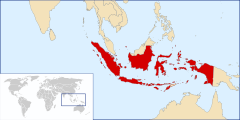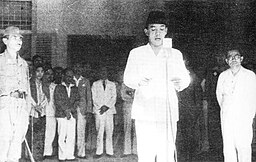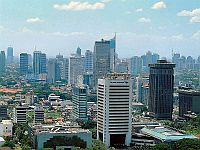
Exploring the history and experiences of mixed heritage persons and inter-racial relationships across the world

Exploring the history and experiences of mixed heritage persons and inter-racial relationships across the world
 You would be hard pressed to think of a more diverse place than Indonesia. Made up of over 17,500 islands, about 6,000 of which are inhabited, spanning the central part of the Far East, its 238 million strong populations is nearly as diverse as the number of large islands, though many ethnic groups are related. The predominantly Muslim population with sizeable Christian and Hindu communities speaks over 500 languages and dialects! It is difficult to image how a country like that could function but the despite the differences, there is an ‘Indonesian’ identity that all the ethnic groups relate to, a lesson that many countries particularly in Africa could learn. This national identity is probably reinforced by the use the Indonesian (related to the Malay) as the official language as opposed to Dutch, the language of the ex-colonialists. For many Indonesians though the official language is a second language with many local ethnic languages as the mother tongue of many citizens.
You would be hard pressed to think of a more diverse place than Indonesia. Made up of over 17,500 islands, about 6,000 of which are inhabited, spanning the central part of the Far East, its 238 million strong populations is nearly as diverse as the number of large islands, though many ethnic groups are related. The predominantly Muslim population with sizeable Christian and Hindu communities speaks over 500 languages and dialects! It is difficult to image how a country like that could function but the despite the differences, there is an ‘Indonesian’ identity that all the ethnic groups relate to, a lesson that many countries particularly in Africa could learn. This national identity is probably reinforced by the use the Indonesian (related to the Malay) as the official language as opposed to Dutch, the language of the ex-colonialists. For many Indonesians though the official language is a second language with many local ethnic languages as the mother tongue of many citizens.
The fossil known as Java Man is evidence that the Indonesian islands were populated for millennia. The forefathers of the majority of diverse communities were the Austronesian people who are believed to have migrated from Taiwan over the centuries pushing the indigenous communities into far flung corners. The islands were an important trade region proven by the existence of Hindu and Buddhist kingdoms in the early centuries CE and Muslim traders bringing Islam to the region from about the 12th and 13th centuries, sometime before the appearance of the Europeans in the 16th.
The Portuguese were the first Europeans to arrive in 1512 when they sought to gain a foothold in the ‘Spice Islands’ (Maluku). The spices of interest to them included nutmeg, cloves, and cubeb pepper. Dutch and British traders followed later. As happened elsewhere in the world, the Portuguese were not averse to taking up with local women and soon enough a recognisable Mestizo (Mestiço: Portugese; Mestiezen: Dutch) ethnic group developed. The influence of the Portuguese cannot be discounted with these mixed communities existing well into the Dutch occupation and that a mixed Portuguese/Malay language still exists to today in the region.
A notable independent group of Mestizos in the region were the Topasses people who were pre-dominantly living on the Timor island. The descendants from one of the sub-groups, on Flores, called themselves Larantuqueiros. This group were mainly traders controlling the sandalwood trade in the area. They strongly opposed colonial oppression and actually fought a number of wars with both the Dutch and Portuguese. Other Mestizos who opposed the Dutch rule often joined ranks with the Topasses. They have now been assimilated into indigenous nobility of East Timor of today.
In 1602 the Dutch established the Dutch East India Company (VOC) which became the colonisation vehicle in the region, becoming dominant to the detriment of the Portuguese and the British. Though mainly a trading organisation, the company established trading posts mainly in the coastal region and sent some 1 million mainly single male employees to the region. Apparently, only a third of them ever returned to the Netherlands with many dying of disease on their tour of duty but many also choosing to stay with the local families after their tour.
This suited the company fine in that it needed a large ‘European’ presence to run its ever expanding businesses. It is said it even stimulated and even encouraged the growth of this mixed population then known as ‘Indos’ to separate them from the native Dutch European. The Indos were recognized by Dutch law as Europeans playing an important part as officials of company as they normally spoke both Dutch and one of more local dialects. However, the early Indos did not speak Dutch as the main language but Malay, Portugis - a Portuguese/Malay creole, or some other creole language. Over the years, a fairly large community developed and must have become so prevalent in the VOC structures that the company had to reserve many senior company posts for Netherlands born individuals. The community grew large enough for inter-marriages to take place and a growing number of Indos were the result of such unions.
The Indo society was matriarchal .i.e. women were the power brokers and in those early days many powerful Dutch company and government men married into the various clans and were absorbed into the relevant communities. In those days the Europeanisation of these mixed people was not high on the agenda. Many European born men fell into the Indo culture quite easily.
The company did recognise another Portuguese/Malay speaking group known as the Mardijker people as a separate ethnic population, separate from the Indos. Most of them were freed Portuguese slaves or their descendants with ethnic roots in India but of Christian faith. They tended to inter-married with the Portuguese Mestiço community and eventually no longer regarded or recognised as being separate.
 The government of the Netherlands established the Dutch East Indies, Indonesia, as a colony after the Dutch East India Company was dissolved in 1800. The Dutch expanded their influence during this period to extend to what was to become Indonesia's borders. Gradually the pressure to Europeanise, or more precisely take on Dutch language and culture, was being placed on the Indos with the growth of racist and discriminatory policies which sought to curb the influence and power of the group. This was possible with a growing immigrant population from the Netherlands including a growing number of Dutch women.
The government of the Netherlands established the Dutch East Indies, Indonesia, as a colony after the Dutch East India Company was dissolved in 1800. The Dutch expanded their influence during this period to extend to what was to become Indonesia's borders. Gradually the pressure to Europeanise, or more precisely take on Dutch language and culture, was being placed on the Indos with the growth of racist and discriminatory policies which sought to curb the influence and power of the group. This was possible with a growing immigrant population from the Netherlands including a growing number of Dutch women.
The laws and regulations such as those that allowed indigenous men, who were usually educated Christians to obtain ‘European equality’ status (similar to the Portuguese assimilados) and those that allowed them to obtain Dutch citizenship after marrying an Indo woman were introduced and removed after contention from Netherland born colonialists. The growing removal of privileges did result in a growing politicisation of the Indos which early calls for independence from Europe starting around this time.
Despite these set-backs, the Indos retained some of their power and influence forming the majority of the European legal class in the colony to the point that 300,000 of them were registered as Dutch citizens by the beginning of the 2nd World War. Though registered as Dutch citizens, the ethnic composition of the Indos was varied with other European such as Portuguese, Belgian, French and German ancestry and the varied Indonesian ethnic groups such as Javanese, Borneonese and Sumatran making up the various mixes. Additionally to be recognised as an Indo-European, the offspring had to be claimed by the European father, usually formally marrying the Indonesian mother to cement the relationship. Many Indo children went unclaimed and grew up and assimilated into their mother’s ethnic community.
Between 1831 and 1872 by the Dutch colonial army imported 3,000 young West African men from Elmina (now part of Ghana) to Batavia now Jakarta, the capital. Many of these men, later becoming known as the ‘Belanda Hitam’ or the 'Zwarte Hollanders' (Black Dutchmen), were given Dutch nationality, took Dutch names, and were granted Indo-European type privileges. They and their mixed race descendant formed a military class that existed until Indonesia's independence.
After slavery was abolished in 1863 and after the 10 years mandatory ‘apprenticeship’ for ex-slaves, the Dutch used Indonesia, mainly Java as a source of mainly indentured labour to replace the slaves in some of their other colonies at least up until the Second World War. A large number were sent to Suriname where the Javanese descendants make up some 15% of the population today.
 Japanese occupation during World War II ended Dutch rule. The ethnic Indonesian independence movement grew during those years. Unfortunately for many of the Indos, their privileged status as Europeans meant that many were incarcerated in POW camps along with the native born Europeans and thus played very little part in the growing movement. Some 25% of prisoners did not survive the Japanese camps.
Japanese occupation during World War II ended Dutch rule. The ethnic Indonesian independence movement grew during those years. Unfortunately for many of the Indos, their privileged status as Europeans meant that many were incarcerated in POW camps along with the native born Europeans and thus played very little part in the growing movement. Some 25% of prisoners did not survive the Japanese camps.
Two days after the surrender of Japan in August 1945, Indonesia claimed its independence and appointed a new president. The Netherlands, despite not being in a good position to do so, tried to overturn this turn of events militarily and diplomatically but eventually under international pressure recognised the Independent state in December, 1949. During this troublesome period the Indos found themselves the wrong end of the independence movement, some 20,000 died and over 100,000 ‘repatriated’ to a motherland they had never seen before. A further wave of repatriation took place after the Dutch recognition of the state followed by others during and the Dutch ceded New Guinea. In all, up to 1967 some 300,000 immigrants headed for the Netherlands, With tehm went what was left of the Black Dutchmen military contingent.
Some of the later immigrants were Indos who had opted to take Indonesian citizenship at Independence but later found their unpopularity hard to live with and they reverted to their Dutch citizenship. The Dutch removed that option in 1967. Despite that, a sizeable of population of Indos remained including those ‘unclaimed’ European offspring and those who were unable to repatriate due to failure to obtain Dutch travel documents as in the case of orphans.
The modern Indonesian use of the Indo word relates to all mixed European/Indonesian and not just those from the colonial era though the majority are descendants from that era. It is estimated that there are some 1 million Indonesians with European ancestry clustered around big cities such as Jakarta, Bogor, Bandung and Malang making it one of the largest Eurasian communities in the world.
 However in one of the Madurese. Inter-ethnic tensions are rare in this huge nation though the Chinese Indonesians who hold a substantial share of the country’s wealth have been the recipients of ethnic related violence in the past.
However in one of the Madurese. Inter-ethnic tensions are rare in this huge nation though the Chinese Indonesians who hold a substantial share of the country’s wealth have been the recipients of ethnic related violence in the past.
Dutch society in Europe in the 50s was not ready for the dark Dutch. The sheer visual difference of this immigrants ranging from near white to near African Black, many who were sufficiently educated to compete with natives for jobs and competing for housing was certainly a cultural shock. A large percentage of the initial repatriated immigrants felt sufficiently unwelcome to continue onward to the USA where they have been virtually assimilated into American society.
In 1975 when Suriname, another Dutch colony was granted independence, some 100,000 Surinamese immigrated to the Netherlands and amongst them were descendants of the original Javanese labour sent from Indonesia after 1873.
In the Netherlands, in 2001 those who had remained and the later immigrants and including the second generation numbered around half a million people. Based on this figure and now including the third generation it is estimated that there are at least 800.000 Indo-Dutch persons which makes them the largest minority community in the Netherlands. A study in 2007 determined that at least 50% of first generation Indos married a native born Dutch person and about 80% of the second generation have. Like the other large immigrant group, the Surinamese, the Indonesians are said to have integrated well into Dutch society and it now being recognised that by the fifth generation, it is likely that they will have totally assimilated in the European country.
Links